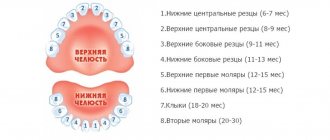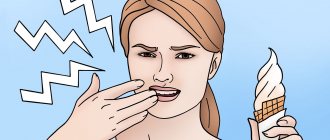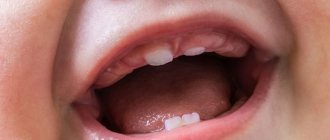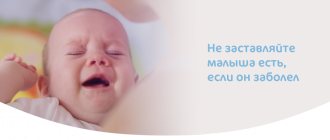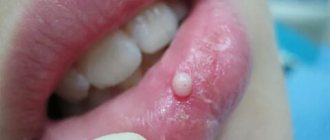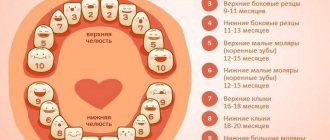When and in what order do baby teeth emerge?
For most children, the teething pattern looks like this:
- At 6-8 months, two central lower incisors appear.
- At 8-9 months, the upper central incisors.
- At 9-12 months, the upper lateral incisors erupt.
- At 11-12 months, the lower lateral incisors.
- At 12-15 months, the upper and lower molars.
- At 16-18 months, the upper canines
- At 18-20 months, the lower canines.
- Chewing teeth erupt at 2-3 years of age.
During normal development, baby teeth erupt in each area within 2-10 days, and the most unpleasant symptoms usually appear within 2-5 days. All 20 baby teeth erupt by age 3.
What to do if teeth are cut chaotically and behind schedule?
There is no need to sound the alarm right away. In some children, teething begins at 3 months, and in some at 10, and this is not a pathology, but a feature of the body. The same applies to the violation of the order of appearance of the incisors.
But if there is a delay of 3-5 months, you need to go for a consultation with a pediatrician or dentist.
Reasons why a baby may have missing teeth:
- delayed physical development (rickets);
- absence of organ rudiments (edentia);
- lack of phosphorus, calcium, vitamin C, D and retinol;
- decreased thyroid activity (hypothyroidism).
Some children are born with a number of “white islands”. Doctors advise removing them so that the mother can freely feed the baby with breast milk. The first molar can come out at 4 months, but this may be a sign of a malfunction of the endocrine system.
What are the common teething symptoms and what do you recommend?
- Profuse salivation.
One of the most obvious signs is when drool is literally flowing in a stream. Moreover, the symptom may appear a couple of months before the start of eruption.
Saliva should be carefully wiped away as it appears damp towel or napkin so as not to damage the skin. It is best to use wipes that contain xylitol - it prevents the growth of bacteria and the appearance of rashes on the skin.
- A strong desire to put everything in the mouth and chew.
Chewing helps your baby relieve the itching. The main thing is to hide objects that he could accidentally swallow or injure himself.
Lifehack. Bend your index finger and gently insert it into your baby's mouth. If he starts squeezing it with his gums, it means teeth are definitely coming out. If it just sucks, then it’s something else.
- Skin rashes.
A small rash on the cheeks or chin may occur due to skin contact with saliva. On irritated skin you just need to apply baby moisturizer.
ATTENTION! If the rash around the mouth appears without other symptoms of teething, it is better to show the child to the pediatrician!
- The baby cannot suckle normally.
At the peak of feeding, he abandons her and begins to act up. And sometimes he can bite with his gums. In such a situation, there is no need to force the child to eat. Even if he misses 2-3 feedings, nothing bad will happen. When he gets really hungry, he will still take the breast or bottle and eat. If you have no appetite for more than 24 hours, call a doctor.
- Redness and swelling of the gums.
It begins 2-5 days before teeth appear, goes away on its own, you don’t need to do anything.
You can also notice a blue bubble on the gum. This is a eruption hematoma. It occurs as a result of the destruction of small vessels in the gums during tooth eruption. It does not require any specific treatment. It will soon resolve on its own.
Symptoms of the appearance of primary incisors
It is difficult to say exactly how long it takes for a child to cut his first teeth, however, parents should know the signs of the appearance of “white islands”. The process of molar growth is accompanied by the following symptoms:
- swelling of the gums;
- excessive salivation;
- tearfulness, irritability;
- low-grade fever;
- sucking foreign objects.
Teething causes anxiety for the baby, manifested by bad mood and constant crying. Due to severe pain, the child sometimes refuses to eat.
Attention! An elevated temperature is not a necessary sign of the appearance of painters; if it does not rise above 37.5 degrees, there is no need to worry. With higher levels, there is a risk of developing a cold due to weak immunity.
What are the complications, and when to see a doctor?
| Symptom | Teeth are being cut, there is no need to go to the pediatrician | The disease develops, contact your pediatrician |
| Cough | A coughing attack begins due to excess salivation. The cough is wet and infrequent. | The cough gets worse, does not go away, does not allow the baby to sleep, and prevents him from eating. Doesn't stop for more than 2 days. Breathe heavily. |
| Nasal discharge | Nasal discharge is transparent and watery and disappears by the 4th day. | The runny nose does not go away for the 4th day. Lots of yellow or green discharge. |
| Heat | The temperature does not exceed 38 °C and lasts no more than 2-3 days. Rapidly decreases under the influence of antipyretics. | Fever above 38.5 °C for more than 2 days. Signs of a cold appear (severe cough and runny nose). |
| Loose stools | Lasts less than 72 hours. | Lasts more than 72 hours. |
| Changes in the oral cavity | The gums become swollen and red. | The oral mucosa is covered with white plaque or ulcers. |
Spells for teething
They say that if you talk to teething teeth, they won’t hurt, but they will crumble! So think a hundred times!
Extreme measures. They don't know if it will help or not. Hope so. My grandmother spoke to me in such a way that my grandmother is no longer here, but my teeth still don’t hurt. I will collect here everything I find on the Internet with links to the source.
Conspiracy one
In order to alleviate the baby's suffering during teething, our grandmothers used the following simple technique. We take a dryer, preferably a stale one, thread a red ribbon through it, and tie three knots. We hold the dryer in our left hand, cross ourselves three times with our right hand and say:
“The teeth are cutting, they are cutting through, the pain goes away and will not remain, it gnaws at itself and makes itself sick, but the servant of God ........ is bypassed. Amen. Amen. Amen."
We read the plot three times, then hang the dryer on the baby’s neck. Let him play with it, chew it, and play with it. It’s fun for him, delicious, and his toothache will immediately go away. (https://soveti-ot-mami.ru/stranno-no-pomogaet/zagovor-pri-prorezivanii-zubov-u-malisha)
Conspiracy two
Lubricate your gums with honey and say three times: “A month, a month, you have a brother Antiny, his teeth grew easily, they never hurt, so the servant of God (the baby’s name) does not have gums, his teeth grow and do not hurt. God grant that my child’s teeth grow easily, don’t hurt, don’t pinch. Amen". (https://www.baby.ru/blogs/post/69475727-41056887/)
Conspiracy three
Give your child a cutting bow and say the magic words. Spell words are read when the baby is teething. The person speaking needs to take a cutting bow and cross it 3 times. Give it to the child in your right hand and say: “On the sea-ocean, on the distant island of Buyan, a vegetable garden has been dug up. Onions sprout there all year round. The chisel onion is cut without tears and without pain, it comes out quickly. Likewise, the servant of God’s baby (name) would cut his teeth without pain and quickly. Forever and ever. Amen".
Conspiracy Four
The ritual is carried out at any time of the day or night when the child is restless due to teething. The person speaking baptizes the baby 3 times and says the following words, rocking the crib: “I baptize with the cross, I want to get rid of God’s servant (name). Your teeth will grow nimble, sharp, you will begin to bite with them and not know grief. Wait, be patient, don’t cry and don’t cry. Amen". (https://www.liveinternet.ru/users/3236844/post300257421/)
Plot five (for the tummy, but it seems to me universal, for all pains)
This spell is done when a baby has a tummy ache.
The speaker must take the icon of the Most Holy Theotokos, cross the child with it 3 times, then pronounce the spell words, applying the icon to the sore stomach: “Most Holy Mary, mother of Jesus Christ, our God, you gave birth to your son, rocked him in a cradle, protected him from all pain. Place your hand on the tummy of God's baby servant (name) so that the pain disappears, goes away forever. Forever and ever. Amen". The sixth spell:
Use a silver spoon to pour water from the vase into a glass (cup) and read the spell 8 times. Spell “To make a child cut teeth easily”
There are yard posts around the hut. Those pillars are white, those pillars are strong, those pillars are straight. The baby (name) is teething, the bone cuts through the bone, the baby does not suffer from pain, the baby’s gums do not turn red, it does not itch, does not hurt, does not swell, the baby (name) does not know pain. A wall of teeth has arisen around the tongue, that wall is strong, white and straight. Tooth by tooth erupts, the baby does not suffer from pain. Amen.
• When the candles burn out, read a prayer of thanksgiving. • Dip a clean little finger into a glass of infused water and lightly rub the baby’s swollen gums with it. Teeth will come through easily. • Boil the spoken water and feed it to the baby. • If teething is difficult and the baby cries and has a fever, then perform the ritual for three days in a row. • Using a baby's silver spoon, tap on the first erupted tooth and read the spell 3 times. All other teeth will erupt easily. • Give the baby the spoken water. • The ritual uses a cup if the baby is a girl and a glass if the baby is a boy.
You can also read the “Virgin Mary” (https://otvet.mail.ru/question/69466054)
Conspiracy seven
In the name of the Father and the Son and the Holy Spirit, now and ever and unto ages of ages. I'll get up. God's servant (her name), having prayed, I will go, crossing myself, from gate to gate, from door to door. I, God’s servant (my name), will go out into the open field. In the open field behind Alatyr, like a stone in the holy monastery, the Virgin Paraskeva lives, God's servant, intercessor of infants and small children. I’ll come closer to her and bow lower to the Virgin Paraskeva. Virgo Paraskeva Friday, pray for the baby (name) The baby’s tooth is cutting, it goes out through the gum. The gums do not hurt, do not itch, do not ache. The baby (name) has no fever, no fever, no fever, no fever. The tooth is milky, bone, strong and sharp. Virgin Paraskeva Friday prayed to the Lord for the baby (name), strengthened the tooth of the baby (name). In the name of the Father and the son and the Holy Spirit, now and ever and unto ages of ages. Amen. Amen. Amen.
(https://gutan.ru/celitelstvo/4-celitelstvo/818-prorezania-zubov.html)
What can be done to help a child with severe itching and pain?
- Carry your baby in your arms more often, play with him and distract him.
- Give chilled water in a bottle, cool fruit puree or kefir. The main thing is that the liquid is not too cold, otherwise the baby will catch a cold.
- Massage the gums with a special silicone brush (see picture above) or you can gently use your clean finger.
- Buy your baby a teether and let's chew.
Such devices are made from plastic, rubber, silicone, wood, or a combination of different materials. The surface of the toys should be elastic and uneven to make it easier for the child to scratch the gums. A cooled teether relieves itching better, so it can be placed in the refrigerator to cool for 10-15 minutes. But don't chill it in the freezer!
- Do not use gum gels with lidocaine and benzocaine.
The child has a lot of saliva in the mouth, so gels are not effective during this period. The child swallows most of the gel.
Content
- How wisdom teeth erupt
- Causes of difficulties
- The danger of late eruption
- How can wisdom teeth erupt faster?
- Negative consequences of late eruption
- Ways to get rid of problems
- Medicines
- Home method
- Surgery
Wisdom teeth are rudiments, organs that have lost their significance. They are the last to be cut, pushing the neighboring ones along the way. It is often accompanied by pain, so you have to see a doctor.
What should you not do when your baby is teething?
- Strongly touch the child’s gums with your fingers, press on them and pick them out. This can increase pain or cause infection.
- Conduct vaccination, because immune system is weakened during this period .
- Without supervision, allow your child to chew any hard foods that could cause choking.
- Give homeopathic remedies. Not only will they not help the child, but they can cause serious harm.
The eruption of baby teeth is not a problem, but a natural process for a child’s body. But if you are not sure about something, do not hesitate to ask specialists. If you have any questions, write to us on Instagram.
How long does it take to transform a smile?
How long it takes for the first tooth to be cut primarily depends on the characteristics of the baby’s body. First, the gums swell - the first stage. From this moment it may take up to 2 months until the first child appears.
The process of cutting through the painter itself can take from 3 to 7 days. At this time, the crumbs constantly drag everything into their mouths, pressing on the problem area, they relieve the pain. A gentle massage of the gums will help eliminate unpleasant discomfort.
You can use a massager, which can be easily purchased in a network of pharmacies and stores. Gels with benzocaine and lidocaine also help reduce the intensity of discomfort. But first you need to make sure that your baby is not allergic to the active components of painkillers.
Before using the gel, it is recommended to place it in the cold, thanks to which blood circulation is delayed and pain is reduced.
What is the danger of late eruption?
There is a possibility of complications not only in the mouth, but also for the whole body:
- With prolonged accumulation of pus, which has no outlet, soft tissue melts, provoking the spread of infection and the formation of abscesses;
- The bite may be affected;
- If a tooth is cut towards the cheek, chronic injury occurs;
- Clamping of the mucous membrane with teeth leads to the appearance of a long-term non-healing wound and, as a result, ulcers;
- The temperature rises, weakness appears;
- Purulent inflammation eventually spreads to the periosteum.
The process is often aggravated by incorrect positioning or impaction of the tooth:
- Pericoronitis develops - the gingival hood becomes inflamed, as food accumulates in it and pathogenic bacteria multiply; in the absence of timely treatment, osteomyelitis and periostitis develop;
- A completely impacted tooth is the cause of neuralgia, facial pain, and cysts;
- With a horizontal direction of growth, the “figure eight” destroys neighboring teeth, causing caries;
- A wisdom tooth can begin to grow after the installation of a prosthesis, causing a lot of inconvenience to a person.
To prevent the development of complications, you should visit the dentist as soon as possible - the doctor will assess the situation and decide what to do.
Why difficulties arise
Problems can be caused by a number of reasons, including:
- Disturbances in the formation of bone tissue;
- General metabolic disorder;
- Hormonal imbalance;
- Pathological formations in the problem area;
- Incorrect tooth position;
- Lack of free space in the jaw;
- Infection in the root canal;
- Carious cavity;
- Fully hardened and formed bone tissue;
- Inflammation of the gums.
PROMOTION
Inexpensive tooth extraction
from 1000 rub.
Medicines
Using analgesics will eliminate the pain, but its source will remain. Use:
- Anti-inflammatory drugs to reduce fever and swelling (paracetamol, ketorolac, ibuprofen);
- Analgin and local anesthetics reduce tissue sensitivity;
- Antiseptics (miramistin, chlorhexidine) - act on pathogenic microorganisms.
Negative consequences of late eruption of “eights”
The inconvenient location of these teeth for cleaning leads to the accumulation of bacteria and the development of caries, which spreads to neighboring teeth.
Late growth promotes the formation of tumors and cysts.
Maybe:
- Excessive tissue growth that will have to be removed surgically;
- Mechanical displacement of adjacent teeth in the process of freeing up space;
- Violation of the position of the jaws;
- Headache;
- Uneven distribution of load when chewing;
- Formation of traumatic nodes and gingival hood;
- Overhang of the mucous membrane, under which bacteria accumulate.
If measures are not taken in a timely manner, the pathological process will spread, affecting adjacent teeth, cheeks, tongue, chewing muscles, jaw bone and periodontium.

